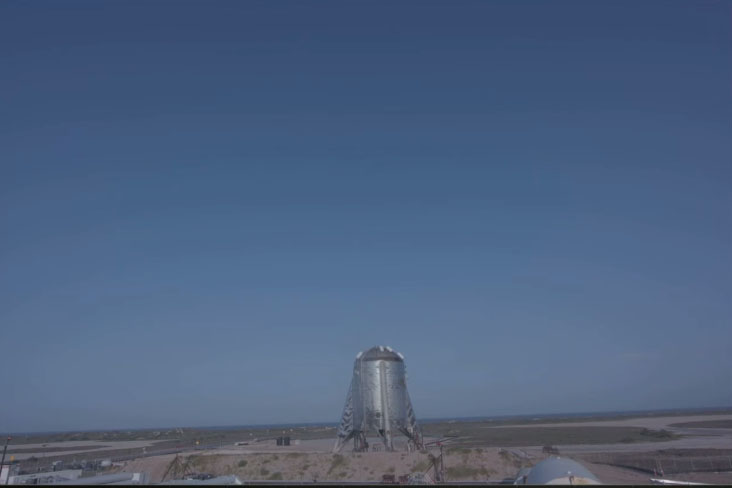SpaceX Aborts Starhopper Rocket Prototype Launch at Last Second
Starhopper's next chance to fly is Aug. 27.

SpaceX called off the planned launch of its Starhopper rocket Monday (Aug. 26) after a last-second abort stalled the much-anticipated demonstration flight. The company hopes to try again Tuesday.
Starhopper, a squat, reusable prototype for SpaceX's planned Starship vehicle, was expected to launch 500 feet (150 meters) straight up and then make a three-point landing during Monday's test at the company's South Texas site near Boca Chica Village. But when the countdown clock reached zero just after 7 p.m. EDT (2300 GMT), Starhopper's single Raptor engine did not ignite.
SpaceX CEO Elon Musk hinted that the problem may have been the igniters on the Raptor, the company's newest rocket engine.
Related: The Evolution of SpaceX Rockets in Pictures
"Raptor uses dual redundant torch igniters. Better long-term, but more finicky in development," Musk wrote in a Twitter statement. For a time, it seemed like SpaceX may attempt a second launch try Monday evening, but the company ultimately opted for a 24-hour delay.
"Igniters need to be inspected," Musk added. "We will try again tomorrow same time."
SpaceX now aims to attempt the Starhopper launch Tuesday, Aug. 27. The area's Cameron County sheriff's department will close roads in Boca Chica neighborhoods near SpaceX's facility for several hours during Tuesday's launch attempt. SpaceX could also try on Wednesday, if needed.
Get the Space.com Newsletter
Breaking space news, the latest updates on rocket launches, skywatching events and more!
Starhopper's next launch has been delayed for nearly a week as SpaceX has worked with the Federal Aviation Administration for launch approvals.
One FAA launch license requirement set the nominal altitude at 500 feet (150 m) — Musk had initially targeted 200 meters for the test — and a maximum propellant load of 30 tons. Another requirement called on SpaceX to boost its liability insurance for the flight from $3 million to $100 million in case of an accident. You can read that experimental launch permit here.
A message reportedly sent to Boca Chica residentsnear SpaceX's facilities warned about the SpaceX test, suggesting they go outside during the flight to "avoid or minimize injury" from broken windows in the event of an accident or explosion.
SpaceX launched the 60-foot (18 m) tall Starhopper on two short, tethered hops earlier this year. On July 25, Starhopper launched of its first free flight and reached a height of about 65 feet (20 m).
Musk has said that this fourth flight, the highest yet for Starhopper, will also be the rocket's final voyage.
"Yes, last flight for Hopper," Musk said via Twitter on Aug. 24. "If all goes well, it will become a vertical test stand for Raptor."
SpaceX built Starhopper as a technology proving ground for its ambitious Starship and Super Heavy rocket project, which aims to develop a massive, fully reusable launch system for trips to low-Earth orbit, the moon, Mars and even point-to-point trips around Earth.
Once Starhopper is retired, SpaceX is expected to turn its attention to its larger Starship prototypes, which will be powered by multiple Raptor engines. The company is building two Starship prototypes, one at the South Texas site and another near the company's Cape Canaveral, Florida launch sites.
- SpaceX's Starship and Super Heavy Mars Rocket in Pictures
- See the Evolution of SpaceX's Rockets in Pictures
- SpaceX's Raptor Engine Hits Power Level for Starship Launches
Email Tariq Malik at tmalik@space.com or follow him @tariqjmalik. Follow us on Twitter @Spacedotcom and on Facebook.
Join our Space Forums to keep talking space on the latest missions, night sky and more! And if you have a news tip, correction or comment, let us know at: community@space.com.

Tariq is the Editor-in-Chief of Space.com and joined the team in 2001, first as an intern and staff writer, and later as an editor. He covers human spaceflight, exploration and space science, as well as skywatching and entertainment. He became Space.com's Managing Editor in 2009 and Editor-in-Chief in 2019. Before joining Space.com, Tariq was a staff reporter for The Los Angeles Times covering education and city beats in La Habra, Fullerton and Huntington Beach. In October 2022, Tariq received the Harry Kolcum Award for excellence in space reporting from the National Space Club Florida Committee. He is also an Eagle Scout (yes, he has the Space Exploration merit badge) and went to Space Camp four times as a kid and a fifth time as an adult. He has journalism degrees from the University of Southern California and New York University. You can find Tariq at Space.com and as the co-host to the This Week In Space podcast with space historian Rod Pyle on the TWiT network. To see his latest project, you can follow Tariq on Twitter @tariqjmalik.









